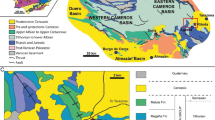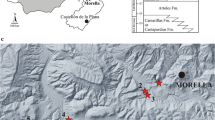Abstract
Background
An assemblage of isolated vertebrate elements from northern Portugal, first described in the early twentieth century, was originally considered comparable to Late Silurian faunas from the Lower Old Red Sandstone of the Welsh Borderlands, but with some anomalous identifications of taxa only known from late Early Devonian or younger deposits.
Purpose
The assemblage was re-evaluated to determine the validity of the original taxonomic assessments and to compare the fauna with associations in other regions to estimate its likely age.
Methods
The specimens were examined and photographed, and compared with mid-Palaeozoic taxa from other regions.
Results
A review of the assemblage shows it to comprise acanthodian fin spines, dentigerous jaw bones, tooth whorls, and a dermal plate, as well as invertebrate remains including phyllocarid mandibles and pterygotid eurypterid exoskeletal plates. Acanthodian elements are assigned to Onchus tenuistriatus, Onchus sp., Climatius sp., and Ischnacanthus sp.
Conclusion
In contrast to the benthic invertebrate fauna from the same locality, which shows marked Armorican affinities, the association of the pelagic acanthodians and pterygotid is most comparable with vertebrate assemblages found in the Přídolí and earliest Devonian of the Welsh Borderlands.
Resumen
En el presente trabajo se estudia una asociación de restos aislados de vertebrados del norte de Portugal, descrito por primera vez a principios del siglo XX, y que se consideró en su mayor parte comparable a las faunas del Silurico Tardío de la parte inferior de las “Old Red Sandstones” de las fronteras Galesas. La revisión de los restos muestra una asociacion formada por espinas de las aletas dorsales, huesos de la mandíbula dentigeros, dientes en espiral, y una placa dérmica de acantodios, así como restos del invertebrados incluyendo las mandíbulas del filocaridos y placas del exoesqueleto de euriptéridos pterigotoides. Los distintos elementos de Acantodios se han asignan a O. tenuistriatus, Onchus sp., Climatius sp., e Ischnacanthus sp. En contraste con la fauna de invertebrados bentónicos de la misma localidad, que muestran marcadas afinidades armoricanas, la asociación de estos acantodios y pterigotóides pelágicos se asemejan son más comparable con las asociaciones de vertebrados encontrados en el Přídolí y el Devónico más temprano de las fronteras galesas.







Similar content being viewed by others
References
Agassiz, L. (1833–1843). Recherches sur les poissons fossiles. 5 vols and atlas. Neuchâtel: Imprimerie de Petitpierre et Prince.
Agassiz, L. (1844–1845). Monographie de poissons fossiles des Vieux Grès Rouges ou Système Dévonien (Old Red Sandstone) des Îles Britanniques et de Russie. Neuchâtel: Imprimerie de H. Wolfrath.
Bernacsek, G. M., & Dineley, D. L. (1977). New acanthodians from the Delorme Formation (Lower Devonian) of N.W.T, Canada. Palaeontographica A, 158, 1–25.
Blieck, A. (1982). Les grandes lignes de la biogéographie des Hétérostracés du Silurien supérieur–Dévonien inférieur dans le domaine nord-atlantique. Palaeogeography, Palaeoclimatology, Palaeoecology, 38, 283–316.
Botella, H., Manzanares, E., Ferrón, H. G., & Martínez-Pérez, C. (2014). Obruchevacanthus ireneae gen. et sp. nov., a new ischnacanthiform (Acanthodii) from the Lower Devonian of Spain. Paleontological Journal, 48(10), 1067–1076. doi:10.1134/s0031030114100025.
Botella, H., Martínez-Pérez, C., & Soler-Gijón, R. (2012). Machaeracanthus goujeti n. sp. (Acanthodii) from the Lower Devonian of Spain and northwest France, with special reference to spine histology. Geodiversitas, 34(4), 761–783. doi:10.5252/g2012n4a3.
Budil, P., Collette, J., & Manda, Š. (2010). An unusual occurrence of the Laurentian phyllocarid crustacean Ceratiocaris papilio Salter in the lower Ludfordian (Silurian) of Bohemia (peri-Gondwana). Bulletin of Geosciences, 85, 551–564. doi:10.3140/bull.geosci.1212.
Burrow, C. J. (2011). A partial articulated acanthodian from the Silurian of New Brunswick, Canada. Canadian Journal of Earth Sciences, 48, 1329–1341. doi:10.1139/e11-023.
Burrow, C. J., Davidson, R. G., den Blaauwen, J. L., & Newman, M. J. (2015). Revision of Climatius reticulatus Agassiz, 1844 (Acanthodii, Climatiidae), from the Lower Devonian of Scotland, based on new histological and morphological data. Journal of Vertebrate Paleontology, 35, e913421. doi:10.1080/02724634.2014.913421.
Burrow, C., den Blaauwen, J., Newman, M., & Davidson, R. (2016). The diplacanthid fishes (Acanthodii, Diplacanthiformes, Diplacanthidae) from the Middle Devonian of Scotland. Palaeontologia Electronica, 19, 1–83. http://www.palaeo-electronica.org/content/2016/1398-scottish-diplacanthid-fishes.
Burrow, C. J., Newman, M. J., Davidson, R. G., & den Blaauwen, J. L. (2013). Redescription of Parexus recurvus, an Early Devonian acanthodian from the Midland Valley of Scotland. Alcheringa: An Australasian Journal of Palaeontology, 37, 392–414. doi:10.1080/03115518.2013.765656.
Burrow, C. J., & Rudkin, D. (2014). Oldest near-complete acanthodian: The first vertebrate from the Silurian Bertie Formation Konservat-Lagerstätte, Ontario. PLOS ONE, 9, 7. doi:10.1371/journal.pone.0104171.
Burrow, C. J., & Turner, S. (2010). Reassessment of “Protodus” scoticus from the Early Devonian of Scotland. In D. K. Elliott, J. G. Maisey, X. Yu, & D. Miao (Eds.), Morphology, Phylogeny and Paleobiogeography of Fossil Fishes (pp. 123–144). Munich: Verlag Dr Friedrich Pfeil.
Chlupáč, I., Ferrer, E., Magrans, J., Mañé, R., & Sanz, J. (1997). Early Devonian eurypterids with Bohemian affinities from Catalonia (NE Spain). Batalleria, 7, 9–21.
Clarke, J.M., & Ruedemann, R. (1912). The Eurypterida of New York. New York State Museum Memoir 14.
Claypole, E. W. (1884). Preliminary note on some fossil fishes recently discovered in the Silurian Rocks of North America. The American Naturalist, 18, 1222–1226.
Denison, R. H. (1979). Acanthodii. In H.-P. Schultze (Ed.), Handbook of Paleoichthyology, Part 5 (p. 62). Stuttgart: Gustav Fischer Verlag.
Dineley, D. L., & Metcalf, S. J. (1999). Fossil fishes of Great Britain (p. 675). UK: Geological Conservation Review, Joint Nature Conservation Committee Peterborough.
Dupret, V., Carls, P., Martínez-Pérez, C., & Botella, H. (2011). First Perigondwanan record of actinolepids (Vertebrata: Placodermi: Arthrodira) from the Lochkovian (Early Devonian) of Spain and its palaeobiogeographic significance. Palaeogeography, Palaeoclimatology, Palaeoecology, 310(3), 273–282. doi:10.1016/j.palaeo.2011.07.019.
Egerton, P. G. (1857). Palichthyologic notes. No. 9. On some fish-remains from the neighbourhood of Ludlow. Quarterly Journal of the Geological Society, 13(282–288), 289.
Egerton, P.G. (1861). British fossils. Memoirs of the geological survey of the United Kingdom (British organic remains) Decade, 10, 51–75.
Gagnier, P.-Y., & Wilson, M. V. H. (1996). An unusual acanthodian from northern Canada: Revision of Brochoadmones milesi. Modern Geology, 20, 235–251.
Gonçalves, E. (2015). Cartografia hidrogeológica das áreas de Valongo, de Paredes e de Arouca. Revista Recursos Hídricos, 36, 25–36.
Gourvennec, R., Plusquellec, Y., Pereira, Z., Piçarra, J. M., Menn, J. L., Oliveira, J. T., et al. (2008). A reassessment of the Lochkovian (Lower Devonian) benthic faunas and palynomorphs from the Dornes region (southern Central Iberian Zone, Portugal). Comunicações Geológicas, 95, 5–25.
Hairapetian, V., Blom, H., & Miller, C. G. (2008). Silurian thelodonts from the Niur Formation, central Iran. Acta Palaeontologica Polonica, 53, 85–95. doi:10.4202/app.2008.0105.
Hanke, G. F., Wilson, M. V. H., & Lindoe, L. A. (2001). New species of Silurian acanthodians from the Mackenzie Mountains, Canada. Canadian Journal of Earth Sciences, 38, 1517–1529.
Lelièvre, H., Janvier, P., & Blieck, A. (1993). Silurian-Devonian vertebrate biostratigraphy of western Gondwana and related terranes (South America, Africa, Armorica-Bohemia, Middle East). In J. A. Long (Ed.), Palaeozoic Vertebrate Biostratigraphy and Biogeography (pp. 139–173). London: Belhaven Press.
Loydell, D. K., & Frýda, J. (2011). At what stratigraphical level is the mid Ludfordian (Ludlow, Silurian) positive carbon isotope excursion in the type Ludlow area, Shropshire, England? Bulletin of Geosciences, 86, 197–208. doi:10.3140/bull.geosci.1257.
Mader, H. (1986). Schuppen und Zähne von Acanthodiern und Elasmobranchiern aus dem Unter-Devon Spaniens (Pisces). Göttinger Arbeiten zur Geologie und Paläontologie, 28, 1–59.
Martínez-Pérez, C., Dupret, V., Manzanares, E., & Botella, H. (2010). New data on the Lower Devonian chondrichthyan fauna from Celtiberia (Spain). Journal of Vertebrate Paleontology, 30(5), 1622–1627. doi:10.1080/02724634.2010.501451.
Miles, R. S. (1973). Articulated acanthodian fishes from the Old Red Sandstone of England, with a review of the structure and evolution of the acanthodian shoulder-girdle. Bulletin of the British museum (natural history) Geology, 24, 113–213.
Miller, R. F. (2007a). Pterygotus anglicus Agassiz (Chelicerata: Eurypterida) from Atholville, Lower Devonian Cambellton Formation, New Brunswick, Canada. Palaeontology, 50, 981–999.
Miller, R. F. (2007b). Nineteenth century collections of Pterygotus anglicus Agassiz (Chelicerata; Eurypterida) from the Campbellton Formation, New Brunswick, Canada. Atlantic Geology, 43, 197–209.
Murchison, R. I. (1839). The Silurian System (p. 576). London: J. Murray.
Murchison, R. I. (1854). Siluria (p. 523). London: John Murray.
Newman, M. J., Burrow, C. J., Davidson, R. G., den Blaauwen, J. L., Jones, R. (2017). Comparison of the vertebrate faunas of the Lower Old Red Sandstone of the Anglo-Welsh Basin with contemporary faunas in Scotland. Proceedings of the Geologists' Association. doi:10.1016/j.pgeola.2016.12.007.
Newton, E.T. (1892). Note on a new species of Onychodus from the Lower Old Red Sandstone of Forfar. Geological Magazine Decade 3, 9, 51–52.
Oczlon, M. S. (1990). Ocean currents and unconformities: The North Gondwana Middle Devonian. Geology, 18, 509–512.
Perdigão, J. (1977). O Devónico de S. Felix de Laúndos. Comunicacões do servico Geologico de Portugal, 61, 13–32.
Powrie, J. (1864). On the fossiliferous rocks of Forfarshire and their contents. Quarterly Journal of the Geological Society of London, 20, 413–429.
Priem, F. (1911). Sur des poissons et autres fossiles du Silurien supérieur du Portugal. Comunicacões da Commissao do servico Geologico de Portugal, 8, 1–11.
Robardet, M., & Gutiérrez-Marco, J. C. (2002). Silurian. In W. Gibbons & T. Moreno (Eds.), The geology of Spain (pp. 51–66). London: Geological Society of London.
Salter, J. W. (1859). On the anatomy and affinities of the genus Pterygotus and description of new species of Pterygotus. Memoirs of the Geological Survey of the United Kingdom Monograph, 1, 37–105.
Teixeira, C., & Thadeu, D. (1967): Le Dévonien du Portugal. Proceedings of the International Symposium on the Devonian System (pp. 189–199), Calgary.
Tetlie, O. E. (2007). Distribution and dispersal history of Eurypterida (Chelicerata). Palaeogeography, Palaeoclimatology, Palaeoecology, 252, 557–574. doi:10.1017/S0016756806002536.
Tollerton, V. P. (1989). Morphology, taxonomy, and classification of the Order Eurypterida Burmeister (1843). Journal of Paleontology, 63(5), 642–657.
Turner, S., Burrow, C.J., Williams, R.B., & Tarrant, P. (submitted). Welsh borderland bouillabaisse: Lower Old Red Sandstone fish microfossils and their significance. Proceedings of the Geologists Association.
Valiukevičius, J. J. (1992). First articulated Poracanthodes from the Lower Devonian of Severnaya Zemlya. In E. Mark-Kurik (Ed.), Fossil fishes as living animals (pp. 193–214). Academy of Sciences of Estonia: Tallinn.
Valiukevičius, J. J. (2003). Devonian acanthodians from Severnaya Zemlya Archipelago (Russia). Geodiversitas, 25, 131–204.
von Rohon, J. (1893). Die obersilurischen Fische von Oesel. Teil II. Memoires de l’Académie Impériale des Sciences de St Petersbourg VIIe série, 41(38 Mr.), 1–124.
Wang, R. (1993). Taxonomie, Palökologie und Biostratigraphie der Mikroichthyolithen aus dem Unterdevon Keltiberiens, Spanien. Courier Forschungsinstitut Senckenberg, 161, 1–205.
White, E. I. (1961). The Old Red Sandstone of Brown Clee Hill and the adjacent area, II. Palaeontology. Bulletin of the British museum (natural history) Geology, 5, 243–310.
Woodward, A. S. (1891). Catalogue of the fossil fishes in the British museum (natural history). Part II (p. 567). UK: British Museum (Natural History).
Woodward, A. S. (1906). On a Carboniferous fish fauna from the Mansfield district, Victoria. Memoirs of the National Museum, Melbourne, 1, 1–32.
Acknowledgements
I thank Miguel Ramalho for access to the Delgado collection and help with references, Mike Newman and Jan den Blaauwen for images of NHMUK PV and GSM collection specimens, Emma Barnard for access to NHMUK PV collection specimens, Randy Miller (New Brunswick Museum) for advice on eurypterid anatomy, and the Queensland Museum for provision of basic facilities. I also thank two anonymous reviewers for their helpful comments.
Author information
Authors and Affiliations
Corresponding author
Rights and permissions
About this article
Cite this article
Burrow, C.J. Reassessment of a mid-Palaeozoic vertebrate assemblage from Laúndos, Portugal. J Iber Geol 43, 97–110 (2017). https://doi.org/10.1007/s41513-017-0006-6
Received:
Accepted:
Published:
Issue Date:
DOI: https://doi.org/10.1007/s41513-017-0006-6




